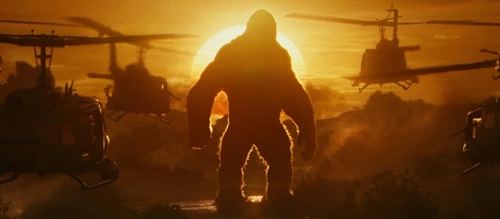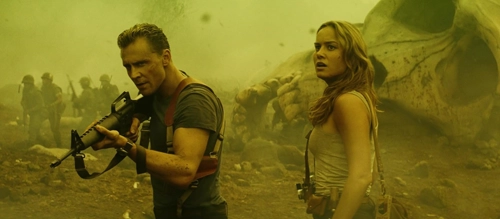Kong: Skull Island (2017) Review

Kong: Skull Island (2017)
Director: Jordan Vogt-Roberts
Screenwriters: Dan Gilroy, Max Borenstein, Derek Connolly
Starring: Tom Hiddleston, Samuel L Jackson, Brie Larson, John C. Reilly, John Goodman, Jing Tian, Toby Kebell, Thomas Mann
After Legendary Pictures came out of the blocks well with Gareth Edwards’s Godzilla in 2014, it was only a few months before they decided to keep the ball rolling with another classic giant monster franchise. And as King Kong had fought Godzilla back in the Toho studio days when they were just rubber suits, why not bring him into the fold? It makes sense, surely. And never mind that we had Peter Jackson’s version of King Kong back in 2005; remakes get made with shorter and shorter gaps between them now; how many different Batman actors have we had in the past couple of decades, or different Spider-Man performers? We just want more of our favourite icons going all out, and Legendary were not going to disappoint.
They roped in some massive names to take an expedition out to a mysterious land known as Skull Island, apparently for geological reasons but really to test the ‘Hollow Earth’ theory. This theory states that there might be tunnels deep underground, filled with monsters we don’t know about, and that there are a few places they can resurface. A bit like Journey to the Centre of the Earth which, considering the original 1933 film had to pass some copyright claims from the Arthur Conan Doyle estate for nicking ideas from his novel “The Lost World”, isn’t too surprising. These scientists believe that Skull Island might be one of these holes in the earth. When they get there, their helicopters are ripped out of the sky by something which resembles a gigantic ape defending its kingdom.
It is clear to see that there was some serious effort and thought put into making this film. In attempt at least, at the drawing board stage, those involved tried to put in some actual craft. You can see the Apocalypse Now influences a mile away, from a coloured smoke resembling the famous opening shot of Coppola’s film, to a shot of the helicopters flying to the sun. This time, there’s also a giant ape standing there to greet them as well. This scene of Kong’s appearance to the helicopters, the first for the world’s favourite monkey besides the cold open, is the best sequence in the film. Director Jordan Vogt-Roberts crafts a thrilling, if not emotionally resonant, scene of utter destruction, with a particularly effective shot held long inside one of the doomed aircraft as it plunges to the ground, everything held in grim suspense waiting for the fireball to rip through the craft.
Whilst the characters may have the age-old Hollywood blockbuster issue of there being too many people in far too stereotypical roles to be of any interest, the best two must be Samuel L. Jackson’s Colonel Packard, and John C. Reilly’s Marlow. Marlow is one of two characters, including Tom Hiddleston’s James Conrad, named for their “Heart of Darkness” reference; the novel being written by Joseph Conrad and featuring main character Marlow. The book of course got the Vietnam treatment as the aforementioned Apocalypse Now – Marlow even appears to the cast much like Dennis Hopper’s character in that movie. It’s a shame that this sense of dread and darkness from Coppola’s film doesn’t carry over to Skull Island, however. Marlow has one too many quips and attempts at humour to seem like a genuine human being, despite a tragic backstory about a wife he had before leaving during WWII and getting stranded on the island, made worse with jokes intercut by other characters to demean what should be emotive moments. At least he has a backstory and attempts at actual humanity, unlike vast swathes of the the other people we’re supposed to care about.

Jackson’s Packard, whilst referred to by Jackson himself as being an Ahab character going after the white whale of Kong, is never given the time like Ahab from “Moby Dick”, or even Quint from Jaws, to be anything other than stock and uninteresting. His rage and grief at losing his men is never shown in anything but blunt, dull demands to keep going, and whilst even a single moment of reflection would have given us something to show he’s human and more than just a plot device to get the cast into danger, the film doesn’t give us that. Why would it? We just want to see big monsters beating things up.
On that front, whilst the monster designs are fun and inventive (the bamboo spider a particular touch of intelligence), they are reduced, for the most part, to being big and unwieldy and with not much more to do other than feature in singular scenic encounters. At no point, aside from the main bad guys of the Skullcrawlers, do we feel any of them are an actual threat. Why should we? They’ll never come close to harming our main cast, with Hiddleston and Brie Larson skipping through the mayhem and madness without a single scratch, the impervious superheroes they are and will become seemingly cloaking them with plot armour even in a jungle of monsters of gigantic proportion.
To some extent, it is this superhero tonal interpretation which hampers the film. The main characters are there to get us from monster moment to monster moment. They are there to make wisecracks and watch lower-paid cast members get picked off, and have seemingly nothing attaching them to the real world which would give us a flicker of worry for their wellbeing. In big action films of this kind, it is the hero’s invincibility, their superhuman nature, which is key; we are meant to feel we can want to be them, to face our fears without worry. They don’t represent us, but they represent an impossible ideal. Other interpretations of modern kaiju films, such as Godzilla Minus One (which would come six years later), would treat their characters very differently, as people weak and full of doubt for their family, but who stand to attention despite this, who suffer setback after setback and defeat after defeat, and still continue on. It is a consciously far more human approach to the use of character.
And so, despite it being a handsomely made picture with glorious visuals and good monster-mashing mayhem, there’s a lack of emotion behind Kong: Skull Island. It doesn’t feel. By the time it thinks to try, we haven’t been bothered for hours. You’ll get some good screensavers out of this film, but not much more.
Score: 12/24
Recommended for you: 10 Best Godzilla Franchise Monsters

